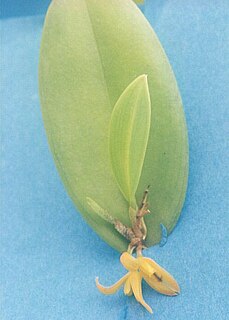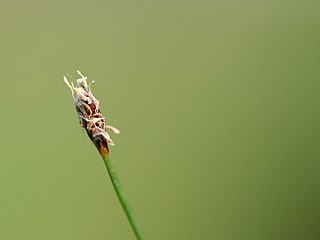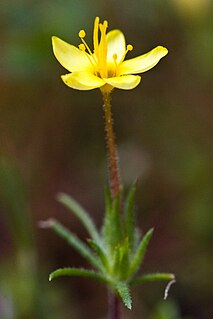
Pleurothallis, abbreviated Pths in horticultural trade, is a genus of orchids commonly named bonnet orchids. The genus name is derived from the Greek word 'pleurothallos', meaning 'riblike branches'. This refers to the rib-like stems of many species.

The Pleurothallidinae are a neotropical subtribe of plants of the orchid family (Orchidaceae) including 29 genera in more than 4000 species.

Specklinia is a genus of orchids native to South America, Central America, Mexico and the West Indies. It contains approximately 80-100 accepted species.

Orites is a genus of 9 known species, 7 endemic to Australia and 2 in South America; 1 in the Chilean Andes and 1 in Bolivia.

Rosa acicularis, also known as the prickly wild rose, the prickly rose, the bristly rose, the wild rose and the Arctic rose, is a species of wild rose with a Holarctic distribution in northern regions of Asia, Europe, and North America.

Eleocharis acicularis is a species of spikesedge known by the common names needle spikerush and least spikerush. It is widespread across Europe, central and southeastern Asia, North America and northeastern South America as far south as Ecuador. It is also found in Australia, where it is probably an introduced species.

Leptosiphon acicularis is a species of flowering plant in the phlox family known by the common names bristly linanthus and bristly leptosiphon.

Acacia brownii, commonly known as heath wattle, is an erect or spreading shrub which is endemic to eastern Australia.

Pilophorus acicularis, commonly known as the nail lichen or the devil's matchstick, is a species of lichen in the family Cladoniaceae.

Orites revolutus , also known as narrow-leaf orites, is a Tasmanian endemic plant species in the family Proteaceae. Scottish botanist Robert Brown formally described the species in Transactions of the Linnean Society of London in 1810 from a specimen collected at Lake St Clair. Abundant in alpine and subalpine heath, it is a small to medium shrub 0.5 to 1.5 m tall, with relatively small, blunt leaves with strongly revolute margins. The white flowers grow on terminal spikes during summer. Being proteaceaous, O. revolutus is likely to provide a substantial food source for nectivorous animal species within its range.

Persoonia acicularis is a species of flowering plant in the family Proteaceae and is endemic to the west coast of Western Australia. It is a shrub with linear, sharply-pointed leaves and yellow flowers in groups of up to eighty.

Petrophile acicularis is a species of flowering plant in the family Proteaceae and is endemic to southwestern Western Australia. It is a low, tufted shrub with cylindrical leaves and oval heads of densely hairy, cream-coloured flowers.

Petrophile anceps is a species of flowering plant in the family Proteaceae and is endemic to a restricted part of southwestern Western Australia. It is a shrub with sharply-pointed, linear leaves and oval heads of hairy yellow flowers.

Orites acicularis, commonly known as yellow bush, is an angiosperm endemic to Tasmania, Australia and is a member of the genus Orites within the family Proteaceae. The species was first described in 1810 by Scottish botanist Robert Brown in Transactions of the Linnean Society of London.

Dianthus acicularis is a species of pink in the carnation family mostly found in the Urals region; eastern European Russia and western Siberia, with some occurrences in Kazakhstan, and Xinjiang in China. A diploid, its resistance to bacterial wilt of carnation and ease of cell line propagation in the laboratory make it useful for breeding ornamental carnations for the cut flower industry.
Specklinia acanthodes is a species of orchid plant native to Ecuador, Bolivia.
Specklinia acrisepala is a species of orchid plant native to Costa Rica and Panama.
Specklinia alexii is a species of orchid plant native to Costa Rica, Nicaragua.
Specklinia alta is a species of orchid plant native to Ecuador.
Specklinia yucatanensis is a species of orchid plant native to Belize, Guatemala, Mexico, Nicaragua.














